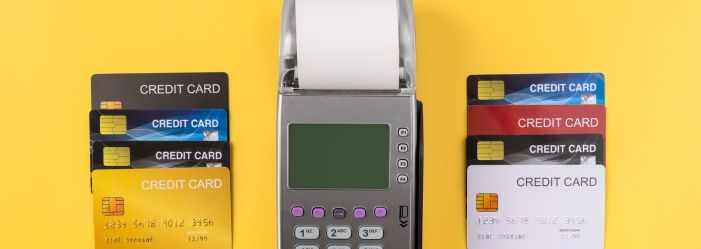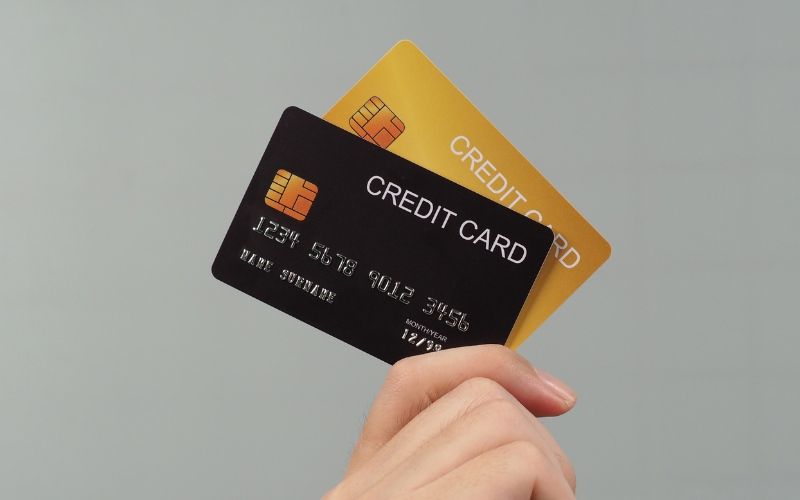March 29, 2024
The Real Deal on Paying Cards with Cards

Disclaimer: We are not qualified legal or tax professionals and are not giving advice. Always speak with a qualified professional before making any legal or financial decisions.
Managing credit card debt can often feel like navigating a complex maze, especially when considering options like paying off one credit card with another. While it might seem like a straightforward solution to debt management or a strategy to maximize rewards, the reality is more nuanced.
This guide explores the feasibility of using one credit card to alleviate the debt of another and dives into alternative strategies that can offer relief without compromising your financial health.
From understanding balance transfers to considering cash advances and other debt management solutions, we'll help you assess the best course of action tailored to your unique financial situation.
Don't want to read through? Speak to a debt specialist right now.
Why You Can't Pay a Credit Card Bill Directly With Another Card
When you receive your monthly credit card statement, you have some options to pay your bill. Most issuers allow payments via check, electronic bank transfer, or money order. But if you've ever tried inputting a different credit card number to pay your credit card bill online or over the phone, you quickly realize it's not permitted.
There are a few reasons why credit card companies don't allow you to pay your balance with another card:
- Increased Risk of Default - Customers who pay one card with another tend to be more likely to eventually default on payments. Issuers want to limit risk.
- Loss of Interest and Fees - Card companies earn revenue from interest charges. Allowing card-to-card payments cuts into this income stream.
- Fraud Potential - Paying cards with other cards opens the door for potential abuse and fraud.
So in short, permitting direct card-to-card payments generates little upside for issuers. The decision comes down to risk management and protecting the profitability of credit card payments.
What is a Balance Transfer?
Since you can only pay credit card bills and can't directly pay a credit card bill with another credit card, what options do you have? Enter balance transfers.
A balance transfer involves moving debt from one credit card over to another credit card and paying another. It's typically done to take advantage of lower interest rates or introductory 0% APR offers on the new card. The process allows you to consolidate multiple balances into one place potentially saving money on interest charges.
For example, let's say you have $5,000 split across two credit cards - $3,000 on Card A with a 15% APR and $2,000 on Card B with a 25% APR. You could transfer the balances to a new Card C that offers 0% interest for the first 12 months on transfers. If approved, you would move the $5,000 total debt over to Card C and pay 0% instead of accruing interest for a year, provided you pay off the full amount during that promotional period.
Balance transfers don't allow you to pay a credit card bill directly with another credit card. But they produce the same net effect - using one existing credit card balance, to pay off another.
Pros of Balance Transfers
Balance transfers can be an effective method for saving money and consolidating debt, but they aren't perfect. There are some key benefits and drawbacks to consider.
Introductory 0% APR Offers
The biggest incentive for completing a balance transfer is taking advantage of intro 0% APR promotions. Most balance transfer cards offer a 0% intro period typically lasting between 12 and 18 months, but some last up to nearly 2 years.
As long as you pay off the entire balance or full transferred balance by the end of the 0% term, you avoid paying any interest. Understand more about the implications of paying off your credit card in full to make informed decisions. This frees up cash flow that can be put toward paying down balances on other cards or loans.
Consolidating Multiple Balances
Transferring scattered balances from various cards onto a single card simplifies management. You have just one payment to make each month rather than keeping track of several. Automating monthly payments on the new consolidated balance is easier.
Lower Credit Utilization
In addition to the benefits mentioned above, balance transfers can lower your overall credit utilization ratio. This is because when you transfer debt from one card to another, it frees up credit on the first card while simultaneously increasing the available credit on the card receiving the balance transfer credit card.
Lower credit utilization is a major factor in boosting credit scores. However, it's important to avoid running up those newly "empty" cards again.
Cons of Balance Transfers
Balance Transfer Fees
Most balance transfer offers come with an upfront fee that's a percentage of the amount transferred. This ranges from 3% to 5% typically. On a $5,000 transfer, a 3% fee would equal $150.
It's important to run the numbers and determine if the interest savings outweigh the transfer fees. You can use a balance transfer calculator to help with the math.
Eventual Interest Charges
One risk to note is that intro 0% APR promotions do eventually end. If any balance remains after the intro period, regular interest charges apply. And the ongoing APR is sometimes even higher than the original credit card issuer's rate.
It's key to have a repayment plan to wipe out balances before deferred interest kicks in to avoid getting hit with a higher or lower interest rate than before the transfer.
How to Transfer a Credit Card Balance
If you've weighed the pros and cons and decided a balance transfer makes financial sense.
Here is an overview of the process:
- Identify the Best Offer - Balance transfer terms and fees vary widely across cards. Shop around for one with a lengthy 0% term (15+ months ideally), low fees, and no annual fee. NerdWallet's list of best balance transfer cards is a good starting point.
- Compare Potential Savings - Use a balance transfer calculator to compare estimated interest charges if you keep your current card versus transferring. Make sure the savings exceed any transfer fees.
- Apply for a New Card - Apply for the new balance transfer card you chose. You'll need a credit score of at least 670 for the best approval odds.
- Request Balance Transfer - After getting approved, you can usually request the balance transfer during the online application process. Provide the account number of the card you want to transfer the balance.
- Allow 4-6 Weeks - It takes several weeks for balance transfers to process. Continue making minimum payments on your existing cards until the transfer goes through.
- Pay Off Balance ASAP - Stick to a budget allowing you to pay off the full transferred balance during the promotional 0% APR period. For more strategies on clearing debt and achieving financial freedom, consider these tips on how to pay off debts. Otherwise, interest charges apply.
With a little planning, balance transfers can save you a nice chunk of money in interest fees. But you have to be diligent about your personal loan repayment plan.
What is a Cash Advance?
A cash advance is another way to access funds that can be used to pay off a credit card balance. But unlike balance transfers, cash advances carry major risks and downsides.
With a cash advance, you use your credit card to borrow cash, either via an ATM transaction or bank withdrawal. The money borrowed is added to your card's balance and accrues interest immediately, even during the grace period when no interest is charged on regular purchases.
The interest rate on cash advances averages around 24%, significantly higher than normal credit card APRs. There are also additional fees that typically apply, such as ATM fees. Cash advances do not earn reward points either.
So while a cash advance does provide immediate cash that could be used to pay off another card, the extremely high cost of doing so with a high-interest credit card, makes it an option to avoid in most cases. Debt consolidation loans or even personal loans usually offer much lower interest rates. Learn more about the safety of using credit cards to pay off loans and whether it's a prudent choice for your finances.
Alternatives to Balance Transfers
For those with fair or poor credit, balance transfer options may be limited or come with less favorable terms. Discover the best ways to pay off your credit cards, which can help you find the most effective strategy for your situation.
Here are a few alternatives to consider:
- Debt Management Programs - Nonprofit credit counseling agencies can negotiate lower interest rates on your behalf and set up consolidated repayment plans.
- Pay in Full via Savings - Using a tax refund or other savings to pay off balances avoids interest. But this option depends on having available funds.
- Personal Loans - Banks and online lenders offer installment loans at rates often lower than credit cards, providing fixed monthly payment schedules.
- Nonprofit Credit Counseling - If you're struggling with debt, certified counselors can help assess your situation and discuss options like debt management, budgeting, and credit improvement. Many nonprofits provide this service at no cost.
The key is to explore multiple debt relief solutions beyond balance transfers to find the right fit based on your financial situation and credit standing. Relief is available even for those with less-than-ideal credit scores.
How Balance Transfers Affect Your Credit
Balance transfers don't just impact your debt - they can also affect your credit score.
Here are some key ways:
- Credit Inquiries - Applying for a new credit card triggers a hard inquiry on your credit report, which could lower your score a few points temporarily. However, improving your utilization has a bigger positive impact.
- Lowered Average Age of Accounts - The new card will lower the average age of your credit history, potentially decreasing your score a little.
- Increased Total Credit - As mentioned earlier, your total available credit immediately increases with a new card, helping lower utilization.
- On-Time Payments - Making on-time payments on the new card builds your credit history month by month.
Overall, the pros of balance transfers usually outweigh the cons credit score-wise for people with good credit (670+ scores). Those with poor credit may want to be more cautious.
FAQs
Conclusion
While you can't directly pay off one credit card by charging it to another, there are some indirect options like balance transfers and cash advances that allow you to leverage one credit card debt to pay off another. But each comes with its own set of pros, cons, fees, and financial considerations.
Balance transfers present the best opportunity to save money on interest charges by taking advantage of intro 0% APR offers. However, you need a good credit score to qualify, fees apply, and you must pay off the full balance before the intro period expires to avoid deferred interest.
Cash advances should be avoided in most cases due to extremely high-interest rates and fees. If you have fair or poor credit, alternatives like personal loans, debt management plans, and credit counseling may be better solutions.
The key is having a plan in place to become debt-free as quickly and affordably as possible. While creatively using one credit card to pay off another can help in certain situations, it's not a cure-all. Your best bet is to develop healthy spending habits and focus on boosting your income to maximize payments on your highest-interest debts.
If you are struggling with overwhelming debt and want to explore your debt relief options, Pacific Debt Relief offers a free consultation to assess your financial situation. Our debt specialists can provide objective guidance relevant information and support to help find the right debt relief solution.
*Disclaimer: Pacific Debt Relief explicitly states that it is not a credit repair organization, and its program does not aim to improve individuals' credit scores. The information provided here is intended solely for educational purposes, aiding consumers in making informed decisions regarding credit and debt matters. The content herein does not constitute legal or financial advice. Pacific Debt Relief strongly advises individuals to seek the counsel of qualified professionals before undertaking any legal or financial actions.
✔ Accredited by Better Business Bureau with BBB A+ rating (4.93 rating and 1678 reviews)
✔ US News and World Reports and Bankrate ranked Pacific Debt Relief as one of “The Best Debt Relief Companies of 2024”
✔ 6.9 star rating by BestCompany.com (over 2379 client reviews)
✔ 4.8 star rating by TrustPilot based (over 1613 verified consumer reviews)
✔ ConsumerAffairs.com Accredited (over 544 verified reviews with an average rating of 5 stars)
✔ A Top 10 Rated Compan by TopTenReviews.com , ConsumersAdvocate.com and Top10debtconsolidation.com
✔ 4.6 star rating by Google (229 client reviews)
✔ 100% rating by SuperMoney (9 client reviews)
Reduce Your Credit Card Debt By Up to Half

BBB Reviews | 4.9/5.0 Rating









 Do Not Sell My Personal Information
Do Not Sell My Personal Information